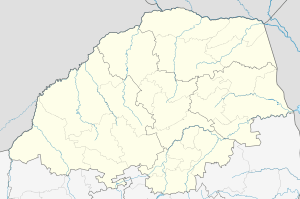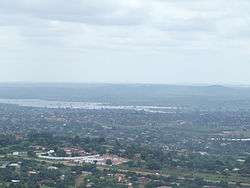Thohoyandou
| Thohoyandou Tshiluvhi | |
|---|---|
|
Nandoni Dam, Thohoyandou | |
 Thohoyandou  Thohoyandou  Thohoyandou
| |
| Coordinates: 22°57′S 30°29′E / 22.950°S 30.483°ECoordinates: 22°57′S 30°29′E / 22.950°S 30.483°E | |
| Country | South Africa |
| Province | Limpopo |
| District | Vhembe |
| Municipality | Thulamela |
| Established | 1977 |
| • Councillor | (ANC) |
| Area[1] | |
| • Total | 42.62 km2 (16.46 sq mi) |
| Population (2011)[1] | |
| • Total | 69,453 |
| • Density | 1,600/km2 (4,200/sq mi) |
| Racial makeup (2011)[1] | |
| • Black African | 95.5% |
| • Coloured | 0.2% |
| • Indian/Asian | 4.1% |
| • White | 0.2% |
| • Other | 0.1% |
| First languages (2011)[1] | |
| • Venda | 84.7% |
| • Tsonga | 2.6% |
| • English | 2.1% |
| • Northern Sotho | 1.2% |
| • Other | 9.4% |
| Postal code (street) | 0950 |
| PO box | 0950 |
| Area code | 015 |
Thohoyandou is a town in the Limpopo Province of South Africa. It is the administrative centre of Vhembe District Municipality and Thulamela Local Municipality. It is also known for being the former capital of the bantustan of Venda. Thohoyandou was built at Tshiluvhi which was under Khosi vho Netshiluvhi. Construction started in 1977 with P East and P West residential area/location as R293 town, a shopping centre and Venda Government buildings. The Netshiluvhis were the first occupants of the area as far back as 1400 AD, i.e. after the collapse of Mapungubwe Kingdom. They were forcefully removed from this area between 1960 and 1970 by the apartheid government of the Venda Bantustan under khosi vho Mphephu Ramabulana. The name Tshiluvhi comes from the Venda word "luvha" which means to pay homages or respect. The former Venda president built his palace and his ministerial resident at Tshiluvhis chiefs kraal as they were already moved by the apartheid government. The following leaders and their subject under Netshiluvhi were forcefully removed from their areas. Some of the Netshiluvhi are known by different names: Malima, Khorommbi, Mathomu, Magidi, and Mudau. The name Tshiluvhi was totally stricken out and replaced by Thohoyandou as per the then government, and was left as a name of a primary school.
History
Thohoyandou became the capital of the former bantustan of Venda, while Dzanani is the traditional capital of Venda and the home of the VhaVenda kings. Thohyandou name means "head of the elephant" in the Venda language, and was the name of one of the VhaVenda kings.
Thohoyandou was established and built at a large portion of the village of Tshiluvhi in the late 1970s. It was established by president Patrick Ramaano Mphephu who was the Prime Minister of the Venda Bantustan. Thohoyandou became the capital of Venda when Venda was declared a republic in 1979, and Thovhele ´Mphephu became the President of the Republic of Venda. Thohoyandou became the centre and economic hub of the Republic of Venda.
A stadium was built in Thohoyandou to celebrate the independence of Venda, and was known as the Venda Independence Stadium. The name was changed to Thohoyandou Stadium in 1994.
Today, Thohoyandou is one of the fastest growing towns in Limpopo. It is also home to the University of Venda.
Residential History
Tshivhumbe
The Netshivhumbe were second to arrive at Tshiluvhi from luonde and they were given shelter on the eastern hill of Netshiluvhis kraal. The name Netshivhumbe came about when they ceased to pay respect to the Netshiluvhis. They were told that "u si di vhumbe vhukoma kha shango li si lau" and the area was named Tshivhumbe. They were called Netshivhumbe but remain subject of Khosi Netshiluvhi.
Samvuni
The Vhanyai Vhasamvuni also arrived at Tshiluvhi to seek residence. They were allocated on the eastern side of Netshivhumbe and settled where there were many Mitamvu trees. The Nesamvunis also came from luonde and they are the cousins of makwinda of Tshivhumbe. The area was later named Mitamvuni under Nemutamvuni which was later changed to Samvuni and they were called Nesamvuni. It was a customary law then, that when you arrive in an area, that you go to the founder of the place and ask for a place to stay. Some of the Vhanyai vhasamvuni are known by different names like Mondeni, Ramunntshi, Nemakope.
Miluwani
The first occupants of Miluwani are Ndous of Murei and these people came from Malamangwa and settled at Miluwani, the Mureis were the weavers of Venda baskets (mifaro) and Venda trays (tselo) from a tree called Muluwa. They came to Khosi Netshiluvhi and asked for a place to stay. They were given ground on the northern hill where he planted a Muluwa tree at his residence and the area was called Miluwani.
Maniini
The village of Maniini also fall under the traditional leadership of Netshiluvhi, and the first occupant of the Ndous who came and settled at Tshikovhani and they were called Ndou dza ha Tshikovha. Originally the Ndous of Tshikovha are from ha Manenzhe and they married a khadzi from ha Mphaphuli. Ndou dza Ha tshikovha are related to Ndou dza Ha Murei of Miluwani. The village was called Maniini because there was a lot of Munii tree which bears a wild fruit called nie or nii.
Magidi
The Magidis and the Netshiluvhis are blood brothers because in the early 1800 Khosi Nedzamba Mudau Netshiluvhi build another kraal at a place he named Tshilungoma because it was a hillock like a drum (Tshiulu tsha ngoma) at a place called Tshavhangona and this is where the Magidi family line was born.
Tshisikule
Tshisikule was an African doctor and medicine man. He arrived at Tshiluvhi from Mount Rida and was allocated a place to shelter his family between Tshivhumbe and Miluwani and as a strong medicine man he was recognized and respected by all, young and old, as well as by traditional leaders. Of recent there is a village named after his original name "Tshisikule" and their clan name is Murida. All these villages now fall under Thohoyandou and Sibasa town and they were all under khosi Netshiluvhi's area of jurisdiction.
Tshiguguvhale
Vhanyai of Tshiguguvhale were the last to arrive at Tshiluvhi and they were allocated a residence where there is Thohoyandou stadium,they were told to go squeeze (u guguvhala) themselves between Mvudi and Lukunde river since there was no other empty space and the area was called Tshiguguvhale.
Thohoyandou is situated in the south of Vhembe district, on the main road between Louis Trichardt and the Kruger National Park. This is the lush agricultural centre of Vhembe, with banana plantations, subtropical fruit, tobacco and maize lands. Thohoyandou is surrounded by small rural townships such as Maungani, Ngovhela, Vondwe, Phiphidi, Muledane, Shayandima, Makwarela, and Maniini.
Economy
Thohoyandou is the main development node in Thulamela Local Municipality with a total of approximately 70 000 residents within the boundaries of the town. It is further surrounded by numerous rural settlements situated on the outskirts of the built-up area.
Thohoyandou's CBD was originally designed as a super mall with large walkways and water fountains, flowers and green areas. The parking lot was situated on the outskirts and people would walk to the shops. Unfortunately, shortage of vacant land within the CBD has slowed down its growth and kept it from expanding further. The CBD has also suffered from a lack of maintenance over the past fifteen years. There is a big mall "Thavhani Mall", that is in the process of being built in Thohoyandou.
Other towns which are next to Thohoyandou are Sibasa, 8 km; Dzanani, 45 km; Malamulele, 45 km; Makhado, 85; Musina, 139 km; and Polokwane, 188 km.
University of Venda
The University of Venda is a South African Comprehensive rural based university, located in Thohoyandou in Limpopo province. It was established in 1982 under the then Republic of Venda government.
The University of Venda has one main Campus in Thohoyandou. The campus houses all seven faculties of the institution namely The School of Agriculture, School of Education, School of Environmental Science, School of Health Sciences, School of Human and Social Sciences, School of Management Sciences, School of Mathematical and Natural Sciences and The Univen School of Law.
The campus also houses the Art Gallery, which has a display of carvings, paintings and clay pots made by both students and local community members. Furthermore, the campus has a full-time Sports Center that is used for indoor sports as well as other recreational activities such as drama and dance. The main campus houses nine of the eleven official residences, namely Bernard Ncube, Carousel, F3, F4, F5, Lost City Boys, Lost City Girls, Mango Groove, Riverside and Prefab.
Colleges
Schools
- Tshiluvhi Primary School
- Herman Technical High School
- Liivha Combined School
- Marude Secondary School
- Thohoyandou Secondary School
- Thohoyandou Technical High School
- Tshikevha Christian School
- Tshishonga Primary School
- Magidi Primary School
- Gindikindi Primary School
- Miluwani Primary School
- Mbaleni primary school
- Mmbara primary school
- Maniini primary school
- Mphaphuli secondary school
- Tshilungoma primary school
- Muratho primary school
- Mvudi primary school
- Thivhilaeli secondary school
Shayandima Secondary School
References
- 1 2 3 4 "Main Place Thohoyandou". Census 2011.

.svg.png)